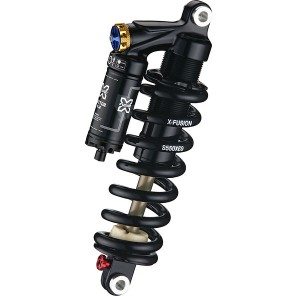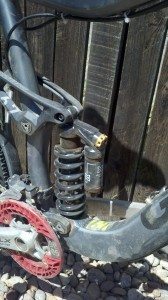Product: 2011 X-Fusion Vector HLR rear shock
Intended Use: XC, trail, AM, DH/freeride
Rider: 6’2”, 205 lbs., athletic, technically proficient, modestly fast and relatively fluid.
Test Location: Colorado Front Range. Steep, fast, rough, rocky trails. Generally in dry, dusty, loose over hardpack, pebbly terrain, but plenty of smooth buffed trail and dirt / loam.

Bike: 2010 Giant Reign X, 170mm travel, XT build kit, Mavic Crossmax SX wheelset, 32lbs
Duration of test: 8 total days of riding.
Overview: The 2011 X-Fusion Vector rear shock is offered in 2 trims: the RC (rebound, compression, spring pre-load) and the HLR (hi-speed compression, low-speed compression, rebound, air volume/bottom out, and reservoir pressure). I opted for the higher end HLR version to test. The shock body is quite light (315g @ 7.78 x 2.25) and very well made. X-Fusion has shown a lot of attention to detail in sculpting the shock body to minimize material. The stock steel spring is fairly heavy in general terms, but totally adequate. I plan to upgrade to a titanium spring and save 100g+ here, but have not done so yet.
Set-Up: On the Vector HLR, I first set my sag to 30% with all the compression valving totally open. I set the rebound to preference, and then went out for a ride and kept cranking up the compression until I went 1-2 clicks too far, and backed it off. It only took an eight mile ride to get the shock feeling really dialed.
Getting the shock to match my bike was a breeze. Each click on the rebound and compression knobs offer a small, but noticeable, adjustment. I did not find myself in-between indents, and settled all adjustments to the middle of their ranges. In short, there’s plenty up and down on each to suit most needs. The shock was very easy to dial in on my first ride, and I have not felt compelled to stray more than 1 or 2 clicks here or there just to confirm that I’ve got it in the right place. Compared to the competition, I feel that the shock was much quicker and easier to get setup to my liking.
Damping: In the same fashion as the fork, the Vector is ridiculously smooth and sensitive, so I would end up running more compression damping than I normally would on other shocks, really just because there is no downside in terms of harshness. This really makes the bike pedal and accelerate far better, both going up and coming back down, but with all the plushness and smoothness of a downhill bike. I found the shock far easier and quicker to setup than any other shock I have ever ridden with the range of adjustment that it has.
Trail Feel: The X-Fusion Vector HLR is perfectly smooth, perhaps the smoothest, friction-free shock—straight out of the box—on the market. It is incredibly plush and supple and does an outstandingly good job on trail. When you hit a bump, the shock moves exactly the right amount to get around the obstacle, without overreacting and costing the rider time or effort. The shock returns to full extension in a controlled manner, and with one cycle. It does not oscillate. In short: the shock is fluid, controlled, and only moves when required, and stays put when it’s not.
I feel that the Vector HLR out-classes aftermarket-tuned shocks such as PUSH’s Fox and Rockshox tuning offerings, or an Elka Stage 5 custom shock. The shock even rivals far more expensive custom options such as an Avalanche or Cane Creek Double Barrel, however the HLR was far quicker and easier to setup than say, the Double Barrel.
Summary: This shock is, in my opinion, one of the industry leaders in rear suspension, period. The fact that it is several hundred dollars less expensive than the other shocks offering similar performance really is the closing sales argument. The X-Fusion Vector HLR deserves a good strong look if you are in the market for a new coil shock for your bike. There is even an air sprung version of the HLR coming in November 2011, that will be quite interesting to compare to the Vector coil.


I agree HLR is one of the best shocks out there